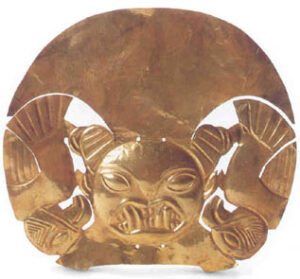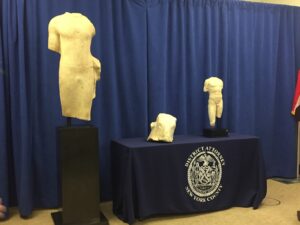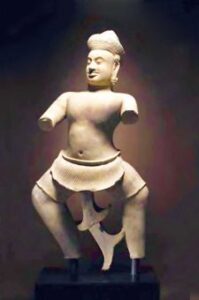ART THEFTS: PART II
Inside Jobs and Insider Knowledge
Many art thefts are indeed crimes of opportunity, including instances of inside jobs. Objects sometimes disappear from storage and then reappear on the market months, or even years, later. Some employees take advantage of internal museum procedures, such as removing a work for photography or cleaning, to waylay an artwork and use it for their own ends. As recounted in Part V of this series, one of the most notorious inside thefts known to the public concerns none other than the Mona Lisa, the most valuable and recognized painting in the world.

Copyright Guggenheim Foundation
In 1990, the Solomon R. Guggenheim Museum in New York sued Jules Lubell for the return of a Marc Chagall painting that had been purchased by the collector and her husband in 1967 and worth approximately $200,000. The Lubells had purchased Menageries from a reputable dealer, the Robert Elkon Gallery. The invoice and receipt stated that the artwork had been “formerly in the collection of George A. Frankiel, Paris.” As it was later revealed, Mr. Frankiel did not have a Parisian collection, rather he was a mailroom employee at the Manhattan museum. The painting’s provenance stated that Mr. Frankiel had sold the painting to another Manhattan art dealer, Gertrude Stein, before Mr. Elkon had sold it to the Lubells.
The museum had initially been unaware that the work was stolen. Once the institution discovered its disappearance, it formally deaccessioned the painting from its collection after a comprehensive inventory. However, the museum failed to take any actions to recover the work, such as publicizing the theft, hiring of a private investigator, filing of an insurance claim, or initiating a search beyond its premises. The museum justified its lack of action due to its belief that it would hinder the work’s recovery and potentially drive it deeper underground on the black market. The museum only became aware of the its location in 1985 when a dealer, acting on behalf of Mrs. Lubell, presented an image of the work to Sotheby’s for an auction estimate. A former Guggenheim employee, the Sotheby’s specialist recognized the work and notified the Guggenheim about its missing property. The museum demanded that Mrs. Lubell return the Chagall work to the museum, but she refused. In September 1987, the Guggenheim filed a lawsuit. The parties spent years litigating over procedural issues, such as the defenses of statute of limitations and laches. Ultimately, the parties settled out of court in December 1993, one day after the trial had already begun. Although the terms of the agreement are confidential, it is believed that Mrs. Lubell and the art dealers paid the museum the fair market value of the work to compensate it for the loss.

Policemen leave the Residenzschloss Royal Palace that houses the historic Green Vault (Gruenes Gewoelbe) in Dresden, November 27, 2019. (Photo by Robert Michael / dpa / AFP) / Germany OUT (Photo by ROBERT MICHAEL/dpa/AFP via Getty Images)
One of last year’s biggest thefts was likely also committed by individuals with an inside connection to a museum. Dresden’s Green Vault suffered a terrible loss in November when burglars stole eleven irreplaceable and culturally significant pieces of Baroque jewelry from the collection. Criminals sprayed fire extinguishers to cover their tracks after starting a fire at an electrical box that plunged the museum into darkness and deactivated the alarm system. That allowed them to break through the museum’s iron gate and shatter a small window to gain access to the historic Green Vault. Thereafter, they axed the glass vitrines that displayed some of the museum’s exceptional items. Founded by Augustus the Strong (we featured his Persian carpets in another post), an 18th-century prince-elector of Saxony and King of Poland, the Green Vault has one of the greatest collections of Baroque treasures. The stolen objects are estimated to be worth about $1 billion. Sadly, some of the precious jewels have popped up for sale on the dark web, offered for millions of dollars apiece. As the investigation progresses, it appears that the theft was an inside job, with some of the security guards currently under investigation.
In 2014, an anonymous source informed the Turkish cultural minister about an organized crime syndicate that used an insider to steal works from the State Art and Sculpture Museum in Ankara, Turkey. According to an anonymous source, the gang earned a whopping $250 million from their thefts. They purportedly stole artworks and antiquities from the museum between 2005 and 2009, some of which were replaced by fakes or other objects of dubious authenticity. In other cases, the items were simply removed from the museum’s storage facilities. Notably, the museum had received criticism for its inadequate inventory system prior to the crimes. That same year, it was announced that another museum had difficulties with inventorying of its collection because hundreds of artworks were missing from El Museo del Prado in Madrid. Spain’s Tribunal de Cuentas (the Court of Auditors) investigated the matter and determined that the losses were not recent but had occurred over the course of decades. Although some losses were the result of fire or war, other losses went unnoticed due to a subpar tracking and inventory system. Unfortunately, many institutions around the world do not adequately inventory and track their holdings.
Thefts from Private Collections
Works are also frequently stolen from private collections. For instance, the law firm of Borghese Associés SELARL handled a case involving Picasso’s heirs and their electrician uncovered the theft of hundreds of the artist’s artworks during proceedings that took over a decade to complete.
In 2009, Pierre Le Guennec, the electrician who had installed a security system in Pablo Picasso’s villa Notre Dame de Vie in Mougins during 1971, revealed that he had 271 undocumented artworks in his possession. Mr. Le Guennec claimed the artist gifted to him the works as a token of appreciation. These artworks have not been signed or inventoried at the time of the painter’s death in 1973. The pieces resurfaced years later when Mr. Le Guennec requested Claude Ruiz-Picasso, the artist’s son, to authenticate 180 watercolor paintings, lithographs and Cubist collages, as well as two notebooks with 91 drawings (circa 1900-1932). Together these pieces form a heterogeneous collection of Picasso’s art.
Suspecting that the artworks were stolen, the Picasso heirs filed a complaint with the French court. At first, the electrician claimed that Pablo Picasso gifted the artworks to him on or around 1971 or1972 as a “thank you” for his devoted work for the artist during the early 1970s. However, on appeal, Mr. Le Guennec completely changed his story claiming that the artist’s widow Jacqueline donated the object to him. The case proceeded all the way to the Court of Cassation (France’s highest court) that ultimately overturned the decision of the appellate court, and ruled in favor of the heirs. The Court of Cassation remanded the case to the Lyon Court of Appeals, and in 2019, it finally convicted the electrician and his wife for receiving the 271 artworks. In fact, the court’s 41-page decision determined that the statements of the convicted parties are fraudulent and the provenance of the artworks was flawed beyond a reasonable doubt.
Antiquities Looting

Moche Headdress, Marco Museum Collection
The looting of antiquities is often a crime of opportunity. The very nature of unexcavated objects is that their existence is likely unknown. For undiscovered antiquities, they may not have been seen for millennia. In essence, these objects do not have a modern ownership history (provenance); therefore, it is difficult or sometimes impossible to trace them back to their place of origin.
Antiquities looters around the world are generally motivated by money. Yet not all looters earn substantial financial profits, but rather plunder sites to feed their families. The problem is of a global scale, as poverty in developing nations creates incentives for struggling populations to plunder and sell artifacts to illicit traffickers at low prices. Pillaging also occurs in impoverished regions of developed nations, such as Italy, China, Greece and Cyprus. At the same time, these nations or regions often lack resources to protect archaeological sites, creating an opportunity for the looters. As Jan Pronk noted in a speech given at the Rijsmuseum voor Volkenkunde in Leiden, “After all, if you were poor and someone offered you a year’s salary for every object you found, would you not pick up a spade and start digging?”
Peru serves as an excellent example as it has suffered the extensive loss of its heritage through rampant looting, often done by locals supplying artifacts on the international market. The site of Sipán in Peru dates to approximately 700 BC and is assigned to the Moche Culture. By the mid-1980s, that area had been minimally recorded by archaeologists and government surveyors, and it had not been archaeologically excavated. The famed archaeological treasures from Sipán come from a large man-made mound called Huaca Rajada. Beginning in November 1986, a group of raiders tunneled into Huaca Rajada, and after a few months, the group came upon a few golden objects. Just like in a movie, after cutting a hole into the roof of the tunnel, treasures cascaded down onto the group. The thieves filled sacks with riches but were unable to determine how to split profits from the sale. As a result, one of the looters informed the local authorities about the operation, and it was stopped by police. Sadly, items from Sipán continue appearing on the international market.
Looting During Conflict
Our founder, Leila A. Amineddoleh, served as the cultural heritage law expert for the Manhattan District Attorney’s Office in a matter concerning looted property from Lebanon. In late 2016, the director of the Metropolitan Museum of Art notified Lebanese authorities that a marble bull’s head, on loan to the museum, appeared to have come from the archaeological site of Sidon. In January 2017, the Lebanese Director General of Antiquities demanded its return.

Repatriation ceremony in Manhattan
The bull’s head was excavated near Sidon from the Temple of Eshmun, dedicated to the Phoenician god of healing. The site was occupied from the 7th century BC to the 8th century AD. Rediscovered in 1900, famed French archaeologist Maurice Dunand excavated the site from 1963 until the start of the Lebanese Civil War in 1975. During a state-sponsored excavation, Dunand discovered the Bull’s Head in 1967. The marble was from the capital of a pillar from the Temple of Eshmun, and it was carved between the 6th and 4th centuries BC, when Lebanon’s Phoenician civilization was ruled by Persia, and its art was influenced by Greek and Persian but also influenced by Greek sources. The head’s discovery was well-documented in the official records and academic sources of the state. Documentation also reports that during the nation’s civil war, the sculpture was moved in 1979 to Beirut to be placed into a secure storage area of the Byblos Citadel for safekeeping. Sadly, the citadel was breached in 1981, and the Bull’s Head was stolen.
The marble went missing for over three and a half decades and then appeared at the Met on loan from collector Michael Steinhardt who had purchased it from other collectors, William and Lynda Beierwaltes. Once Mr. Steinhardt was informed of the work’s problematic provenance, he demanded a refund for the purchase and transferred the title to the object back to the sellers. The movement of the piece from 1981 through 2017 was reconstructed through shipping forms and sales receipts, including documents from dealers known to trade in problematic antiquities. The collectors and dealers involved all claimed they had the right to buy and sell the sculpture. Importantly though, missing from that paperwork was the necessary permission from Lebanon to remove the marble from its borders or sell it. Ultimately, the Bull’s Head was repatriated to Lebanon, in part due to the records and the lack of verifiable legitimate provenance. Sadly, more than 500 Eshmun statues were looted from the Byblos Citadel, and only a handful have been returned to Lebanon. Additional details about the journey of the Bull’s Head can be found here.
Cambodia experienced a brutal period of conflicts and civil wars in the 1960s and 1970s, during which time the archaeological site of Koh Ker fell victim to extensive looting. The dispute over a 10th century sandstone statue of epic warrior Duryodhana began in 2011 when the Kingdom of Cambodia initiated legal action against Sotheby’s. The auction house was selling a 10th century sculpture, that was purportedly looted in or around 1972 from Koh Ker. In fact, experts could pinpoint the exact place from where the statue originated because the base and feet remain in situ.

Photo courtesy of Phnom Penh Post
After being violently removed from its base, the Khmer statue entered the black market and was sold to a Belgian collector in 1975. The collector’s wife consigned the statue for sale at an auction in 2010 and imported it into the U.S. An auction house researcher expressed concerns about the object, stating in an email that she believed it was stolen. That expert later changed her opinion about the sale and advised Sotheby’s that Cambodia generally doesn’t request the return of looted art. On the day of the auction, Cambodian officials demanded that Sotheby’s withdraw the lot and return the statue. Sotheby’s withdrew the item but supported the collector’s ownership claims. The U.S. Department of Homeland Security opened an investigation, and the U.S. filed for a forfeiture. In December 2013, the U.S. government and Sotheby’s ultimately signed a settlement agreement and Sotheby’s returned the statue to Cambodia. Due to that case, the Cambodian government began investigating a number of works taken from the same site. Consequently, a number of similar statues were returned. Around the time of the Sotheby’s return, the Norton Simon Museum repatriated its own looted Cambodian statute to its home. Rather than litigate, the museum offered to return the statue as a “gift.”
Protection of art and cultural objects during the uncertain times of COVID-19
World War II led to a vast displacement of art, conflict in the Middle East resulted in wide-scale looting, and poverty in many “source” nations has been the driving force behind the illicit plunder. The global COVID-19 pandemic’s effect on the cultural institutions and private collections is still uncertain; however, players within the market must prepare for various ramifications of this disaster.
Cultural institutions and museums of all types and origins face similar challenges, such as maintaining high levels of security and preservation of the collections, providing their staff with a healthy and safe work environment, soliciting financial endowments, and digitally engaging with their audiences in a meaningful way. The COVID-19 pandemic has already made it difficult for museums to generate the revenue necessary for covering operational costs and adequately staffing their properties. These shortcomings during a worldwide crisis make institutions vulnerable to theft and may lead to the deterioration of art collections. Economic losses aside, security personnel and conservation specialists of some museums feel that their safety is being compromised while at work, and so they choose not to show up at all. For instance, at the onset of the pandemic in early March, the employees of the Louvre Museum in Paris refused to work, citing COVID-19 health and safety concerns. As a result of the protest, on April 16, the International Council of Museums published a series of recommendations for the conservation of museum collections. The publication urges essential staff, including security guards, to stay on the premises of the institutions in order to “to fulfill their primary function of conserving the material and immaterial heritage of humanity.”
As the pandemic has had an undeniable impact on the finances of art-related businesses, various governmental bodies and private foundations across the world are offering financial relief to those entities and individuals. For instance, the French Ministry of Culture allocated 2 million euros in emergency funding to art galleries, labeled art centers and artists-authors. This funding will be operated by the National Centre for Plastic Arts (“CNAP”) and the regional directorates for cultural affairs (“DRAC”). These resources aim to reduce the adverse impact of the pandemic on the cultural institutions and businesses worldwide.
Only time will tell how the COVID-19 pandemic will change the art market and alter the life of museums. But history suggests that it is essential for museums and collectors to take precautionary measures to safeguard their valuable artistic and cultural holdings.